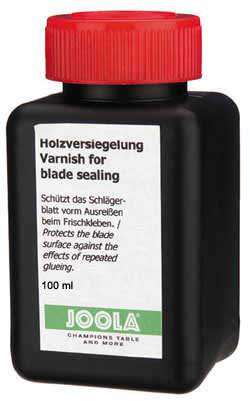How to Seal Your Table Tennis Blade
- Alex Horscroft
- Last updated
Table of Contents
Ever heard of blade sealing in table tennis? If you want to increase your blade’s life, you must embrace table tennis blade sealing.
What is Sealing a Table Tennis Blade?
Sealing a table tennis blade involves adding lacquer to a blade or varnishing a table tennis blade’s head to seal it.
This varnish layer provides a little extra strength and protects the blade from wear and tear, thereby extending its life. It also adds a layer of separation between the rubbers and blade once you glue them together, which makes the rubber easier to remove.
Should I Seal My Table Tennis Blade?
Table tennis blade sealing is a personal choice and comes with several benefits and drawbacks. Ultimately, it’s not a decision as important as your rubber or blade selection, so I wouldn’t stress about the decision either way. But, here are the facts you should know before you decide on table tennis blade sealing.

Benefits of Sealing Your Table Tennis Blade
Protects the Blade
Blades take a lot of damage over time; there’s no avoiding it, even if you’re really careful. Your blade will take impacts from the table and your body, with the majority of this damage occurring along the edge of the blade.
This damage weakens the edges and leaves them vulnerable to splintering. Then, when it’s time to change rubbers, these splinters can lift and increase the damage to your blade even more! Blade sealing in table tennis both strengthens your blade and makes your rubbers easier to remove. This means they are less likely to pull chips of wood away when they are removed.
The more often you change your rubbers, the higher the chances you have of pulling off splinters. Therefore, if you frequently swap them out, maybe around every 1-6 months or so, varnishing is a practice you should certainly consider.
Less Excess Glue
The diminished bond between the rubber and blade through blade sealing means you are rarely left with excess glue when you remove your rubbers. This is useful, as removing excess glue from unvarnished blades can sometimes be a pain. I like to make sure my blade is completely free of old glue before applying a new coat. This process often involves me rubbing off the excess with my finger, which is rather annoying.
Reduced Water Absorption
A less-talked-about issue with table tennis is water absorption. By nature, wood doesn’t react well to water, leading some people to believe that blades need a layer of protection against it. Personally, I feel that is more or less a non-issue. Water-based table tennis glue is specifically designed for gluing rubbers to blades, and it would be counter-intuitive if it caused damage.
It takes a great deal of constant exposure to water before we see wood start to deteriorate, and you don’t get that with water-based ping pong glue. Therefore, I think it’s fair to say you probably don’t need varnish for this reason. But if you are still concerned about water exposure, varnish will certainly help prevent water-based table tennis glue from sinking into the deeper layers of your blade.
Drawbacks of Sealing Your Table Tennis Blade
There are only really two disadvantages of varnishing a table tennis blade. The first is that it isn’t free; but it’s so cheap that it might as well be free. It only costs a couple of dollars for your table tennis supplier to apply a varnish for you.
The main disadvantage to applying varnish is that it weakens the bond between the rubber and blade. This means your glue might not hold, or you might end up with annoying air bubbles where parts have glued effectively and others have not.
I for one have experienced these pesky bubbles. Having purchased my bat varnished from the supplier I had no initial issues. But, when it came time to change my rubbers, I noticed an air bubble shortly after playing with my fresh set.
Given the last rubbers had held fine, I assumed the glue was at fault. But, the rubbers still wouldn’t hold even after switching glue! I even desperately applied mountains of glue in the hope that it would hold before entering a table tennis competition. Long story short, the glue failed in the final, and one of my rubbers was quite literally flapping in the wind. Not an experience I would like to repeat!
I soon after realized the varnish was to blame. I sanded it off and the problem was no more. This is why if you do choose to use varnish on your blade, it’s important that you use a light coat.
How to Seal a Table Tennis Blade
There are two ways to undertake blade lacquering. You can either do it yourself or you can get a supplier to do it for you.
If you are buying a new blade. it makes sense to just ask the supplier to varnish your blade. This way, you don’t have to buy varnish yourself. Alternatively, if you want to varnish an existing blade, you will have to purchase some varnish and undertake the process yourself.
Megaspin provides a blade sealing service for just a few dollars. It’s a no-brainer if you’re buying a new blade.
If, on the other hand, you have to purchase a table tennis blade sealer yourself — we recommend REvolution 3 Lacquer. It comes in an affordable 30ml bottle. However, if you have multiple blades to varnish or plan on re-varnishing often, a larger bottle would be more fitting, like the JOOLA blade sealing varnish.
Below are the steps for varnish application:
- If applicable, remove your rubbers and any existing glue.
- Use fine-grit sandpaper to slightly rough up the blade.
- Remove any dirt or dust.
- Apply varnish evenly across the head and edges of the blade.
- Leave the blade to completely dry.
- Apply another light layer of varnish if needed.
- Leave the blade to completely dry once more.
One or two layers of varnish is plenty. You shouldn’t have to apply any more than that. If you do, you will almost certainly have trouble getting your rubbers to stick to the blade. To rectify that issue, lightly sand away the varnish, as this will increase the bond between the rubbers and the blade.
Here is a helpful video to show you the process of varnishing.
Note: The gentleman in this video also varnishes his handle to provide it with a little extra protection. Most people only varnish the bat head and edges. Varnishing the handle helps to mitigate sweat absorption, but the bat may not feel as comfortable to hold. It will also make the handle a little shiny, which can lessen the aesthetic of your blade.
Closing Thoughts
Sealing your table tennis blade is an easy way to prolong its life. Considering the expense of most blades, it makes sense to take any measure we can to ensure they last.
Varnishing your blade is not only cheap but also easy to do yourself if you can’t get your supplier to do it for you. If you make a mistake, you can always sand away the varnish, but I suspect most of you will have no trouble at all.
Remember, less is more — a coat or two is all you need! You need to still be able to have a strong bond between the rubbers and blade when you glue them together.
You may find our other bat care posts useful. We have guides on replacing your rubbers and keeping them in peak condition.
Freelance writer. Table tennis enthusiast. Lover of all things online. When I’m not working on my loop game I’m probably binge-watching some fantasy show.
-
Alex Horscrofthttps://pingpongruler.com/author/alex-horscroft/
-
Alex Horscrofthttps://pingpongruler.com/author/alex-horscroft/
-
Alex Horscrofthttps://pingpongruler.com/author/alex-horscroft/
-
Alex Horscrofthttps://pingpongruler.com/author/alex-horscroft/
Popular Products
Join our email list for exclusive reviews & the latest Ping Pong News
Sign up to our newsletter and stay up-to-date with the latest news in the ping pong world, and be the first to read our new product reviews. We promise, no spam




















